Whitewater police chief presents council with concerns regarding department’s ability to serve proactively
- Home
- Whitewater police chief presents council with concerns regarding department’s ability to serve proactively
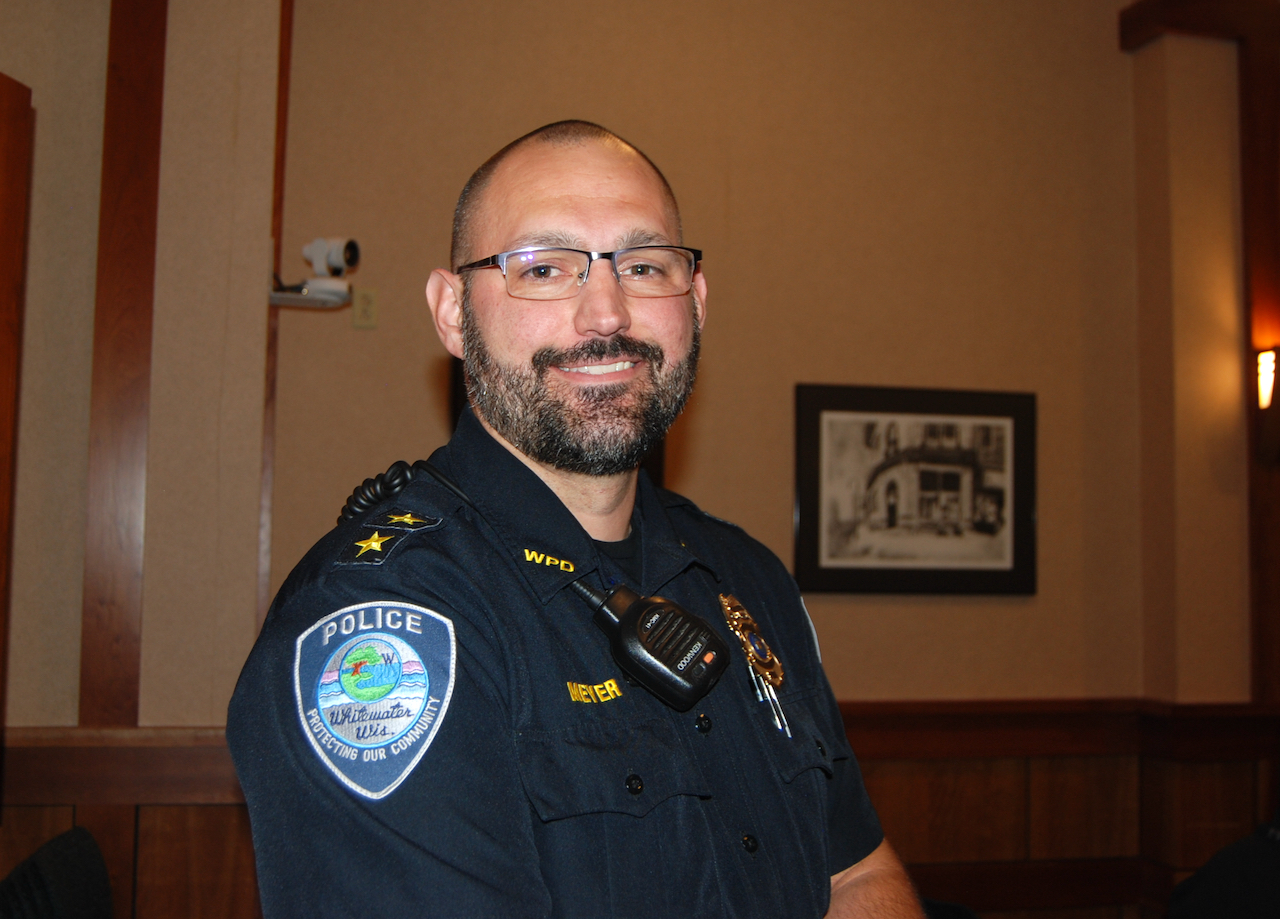
Whitewater police chief presents council with concerns regarding department’s ability to serve proactively
By Kim McDarison
Changes in community demographics and a lack of manpower were among reasons cited last month by Whitewater Police Chief Dan Meyer as he described to members of the Whitewater Common Council his concerns about his department’s decreasing ability to serve the community proactively.
During his presentation, made as part of the council’s regular Sept. 19 meeting, Meyer said he was sharing his concerns for two reasons, citing a desire to be transparent and “ensure that the community has an awareness of where we (the police department) are at, both in terms of what we are doing, but also what we are not able to do,” and, he said, “taking it one step further, these proactive measures that we’re falling behind on are the things that keep this community a safe and desirable place to live.”
Said Meyer: “I do want to start the conversation about how to find a solution. The two solutions that I can think of — and I’m absolutely open to hearing any ideas or thoughts that you all have — is technology, and using — leveraging — that technology to increase our efficiency. That’s something that we’ve been working on, based with what’s within our control.”
In advance of the presentation, Whitewater Common Council President Jim Allen said that councilwoman Jill Gerber had requested that the item be placed on the agenda.
Opening his presentation, Meyer noted that his goal was to “focus on really the reality of the challenges our department faces right now with the current constraints that we have.”
During his presentation, titled: “Whitewater Police Department Data Analysis,” Meyer emphasized his understanding of the importance of allowing police officers to have time that is not obligated.
Such time is important, he said, because it provides officers with an opportunity to perform proactive police work, further allowing them, he said, to remain visible in the community, establish and maintain relationships, ensure safe roadways through traffic enforcement, participate in community engagement programs, decrease response times, perform more thorough investigation and followup, train and avoid burnout.
According to Meyer, his presentation would not “reiterate” crime statistics and information found in an annual report, which, he said, are available to the public through the city’s website.
While he said he considered those documents to hold “very important information,” he added that they “do not tell the entire story.
“That annual report is great, showing what officers are doing, but it’s not showing that opportunity cost in what our officers are unable to do,” he said, adding: “If you look at the pure crime statistics numbers for our department, it looks like (for) the past two to three years now, there’s been relatively little change … but, in reality, there are major changes happening here, and I think the impact of those changes is a detriment to our proactive enforcement efforts.”
A presentation goal, Meyer said, was to “transparently provide critical, albeit less publicized data” as it related to several topics, including mutual aid requests, calls for service from the Whitewater Unified School District, and proactive enforcement measures, such as citations of Operating While Intoxicated (OWIs) or Driving Under the Influence (DUIs), and speeding, and other officer-initiated traffic stops.
Aided by slides, Meyer said, “first and foremost, I think it is important that we have an understanding of what the importance of unobligated time is for our officers.”
He next offered a definition of “obligated time,” saying: “obligated time is really that reactive time where our officers are going to a call, physically going to a call, investigating the initial complaint, collecting any related evidence, and documenting it with a call summary or written report.”
Unobligated time, he said, is spent between calls for service, and involves such activity as “traffic enforcement, relationship building, followup investigation, training, community engagement efforts, and things like that.”
Mutual aid
Under a heading of mutual aid requests, a slide, Meyer said, showed “how often our officers are insufficiently staffed to properly respond to an incident, necessitating a request for officers from an outside agency.”
The slide further stated that three categories of officer-related activity — including officer-initiated traffic stops, DUI incidents, and speeding citations — would bring insight about “how much unobligated time officers have to enforce our laws and ordinances.”
A chart showing “Mutual Aid Requests Data,” including assists from the University of Wisconsin-Whitewater Police, and the Walworth and Jefferson county sheriff’s offices, noted that, in 2022, the department made 342 calls for assistance. To date, in 2023, the Whitewater Police Department has called for mutual aid more than 150 times and is on pace to make the same number of requests as in 2022.
Between 2017 and 2021, the average number of calls for mutual aid was 253.
Meyer said: “What that data is showing is how many times annually our police department is requesting assistance from another law enforcement agency to respond to an incident because our staffing in-house is not sufficient to properly respond.”
He said the important takeaway from the bar graph is that “on average, from 2017 through 2021, we requested outside agencies’ assistance 252.8 times.
“In 2022, that rose to 342, and in 2023, oddly enough, we are on pace again for 342, so we are increasingly unable to handle our calls for service with our resources alone.”
Whitewater Unified School District calls for service
Another bar chart presented by Meyer showed that the calls for service from the Whitewater Unified School District had gone up in the 2021-22 school year most significantly at the Whitewater High School.
Calls for service ranged from issues of truancy to fights and theft.
During the 2021-22 school year, the department responded to nearly 140 calls for service at the high school Calls, too, had risen at the middle school during the 2021-22 school year, with the department responding nearly 100 times.
During the 2022-23 school year, data showed that the department had responded some 130 times to the high school and about 80 times to the middle school.
During the 2019-20 school year, data showed approximately 90 calls made for service at the high school and 70 calls for service at the middle school.
At the elementary school level, data was captured for both Lincoln and Washington. Lakeview, which resides outside of the city limits, was excluded from the chart.
Looking at the two elementary schools, in 2019-20, the department responded most frequently to calls for service at Lincoln. According to the bar graph, the department responded some 30 times. During the same year, police were called to Washington about five times.
During the 2020-21 school year, police responded to calls for service at both elementary school approximately 15 times.
During the 2021-22 school year, calls to Lincoln remained about the same as the number of calls received the previous year, while calls to Washington were down by a small percentage.
During the 2022-23 school year, calls to Lincoln increased to approximately 25 calls, while calls to Washington slightly decreased.
Citing the school-related data, Meyer said it showed “primarily how our school resources officer is handling her time in the schools. He cited truancy within the schools as concerning.
Truancy
Looking specifically at truancy, police responded to 49 offenses during the 2020-21 school year. During the 2021-22 school year, the number rose to 54. During the 2022-23 school year, police responded to 77 truancy offenses, data provided by Meyer showed.
Said Meyer: “The truancy numbers have risen pretty dramatically. We are at 77 as of the last school year. In and of itself, this seems like a minor inconvenience, but truancy is one of the most time consuming issues for our SRO (school resource officer).
“We are seeing trends of students being registered for school, but then they simply stop coming. We are also seeing trends with fake birth certificates used to skew a child’s age. It’s being done both to make them look younger and older; to make them look older so that they can obtain work. So these truancy cases are becoming more common.”
Officer-initiated traffic stops
Aided by a bar graph, Meyer noted that the average number of traffic stops each year between 2010 and 2021 was 2,437.
The number has steadily decreased, the graph showed, noted that in 2022, stops were down to 1,719, and in 2023, the department was “on pace” to make 1,246 stops, which, Meyer said, was roughly half of the average calculated between 2010 and 2021.
“To me, this is probably the most concerning statistic you are going to see tonight. You know I think about 1,200 traffic stops,” he said, adding: “how much good could we have done, whether preventing crime, getting intoxicated drivers off the road, getting drugs out of the community or simply being that reminder to slow down.
“This is a quarterly count of our officer-initiated traffic stop data, so this really comes down to the meat and potatoes of what proactive police work is. Proactive stops are not based on a reported complaint, but instead they are an officer noticing a violation,” Meyer said, which, he added, is “one of the primary ways that we are keeping our roads safe — proactively finding drugs, guns, intoxicated drivers, just generally speaking, finding people doing things they shouldn’t be doing.”
As an example, he noted “one of the reasons why we don’t drive twice the legal speed limit on the way to work when we are late is because there might be an officer sitting there waiting to write us a ticket.”
He cited the activity as a method of deterrence.
Moving to the next slide, Meyer said: “This graph shows that divergence of overall calls for service (CFS) received by the department … versus our ability to conduct proactive traffic stops … So unfortunately what that is showing is a trend of our department getting more and more reactive and less and less proactive.”
DUI data
“Looking at our OWI, or DUI, incident data, again we are looking at an average from 2010 to 2021, over those 11 years or 12 years, we had an average of 101.8 per year, again in 2022, we’re down, to 72, and in ’23, we are on pace for 60,” he said.
Speeding citations
Meyer also shared data showing the average number of yearly citations for speeding written by his officers.
Between 2017 and 2021, the department wrote, on average, 179 citations annually.
In 2022, 120 speeding citations were written, and in 2023, the chart indicated, the department is “on pace” to write 83.
Said Meyer, “looking at speeding citation data, again, they’re all different measures of proactive enforcement.”
A decline in proactive enforcement
Among contributing factors to the decline in proactive enforcement, Meyer identified changes in community demographics, which, he said, bring “significant challenges.” Challenges included issues with language translations, which, he stated, make incidents take longer to investigate.
He noted, in September, that since the department began using translation services through an agency called Propio some nine months earlier, his officers had been on the phone with an interpreter for 61.2 hours.
Meyer said domestic abuse incidents served as an example of a “complex case that would typically take two hours to investigate with native English speakers,” but, he said, a similar case could take “twice as long to handle when dealing with that interpretation.”
Further, he noted that additional time also was spent fingerprinting and photographing individuals who did not have “proper identification.”
Also, he stated, “challenges in the schools carry over to law enforcement.”
Additionally, Meyer said, high priority incidents have resulted in significant longterm investigations.
He cited a case involving a deceased infant found earlier this year near the Twin Oaks mobile home park as among high priority cases which, he said, “take time.”
He said the case “consumed hundreds upon hundreds of hours of investigative resources to properly bring to a charge.”
Meyer next pointed to the department’s efforts to maintain engagement with the community though such programs as Kiwanis Cops ’n Kids Book Reading, Shop with a Cop, and Active Threat Training Presentations, which, he noted, “take time.”
The department has “remained committed” to community outreach, noting that while they also take time, they remain important avenues to “build that trust within the community,” he said.
“So there are numerous factors, in my opinion, that contribute to this decline in proactive enforcement,” he said, adding: “I think it’s important to talk about why this is happening.”
Solutions
Meyer concluded his presentation by offering solutions.
He suggested that the department work to “leverage technology,” through such programs as Propio and its use of drones. He also pointed to automated license plate reader cameras.
Additionally, he cited a need to increase staffing within the city’s police department.
Among positive steps forward, he cited a formalization of the department’s drone team, which, he said, as of last month, had multiple deployments.
The drone team, he said, “helps our officers be more efficient in our investigations.”
He added: “I’m not tone deaf to the budget constraints that our city has at this time. I understand there’s not an easy answer immediately, but, I’m asking to start that conversation to figure out how to make a staffing increase a reality as we look to the future,” he said.
Council discussion
Following the presentation, Allen asked: “We don’t have license plate readers currently in your squad cars, do we?”
Additionally he asked if the readers were expensive.
Meyer said the department’s squad cars did not have the equipment, and the cost to outfit a car was approximately $25,000.
The chief said he believed stand-alone readers, which he described as cameras mounted on posts, would be more beneficial to his department.
He said he would be proposing that the city invest in pole-mounted cameras as part of an upcoming grant request.
Said Gerber: “I think it is really important that the community hears what’s going on at the police department.”
Addressing Meyer, she said: “As you said, a lot of things have changed within the city. I was just wondering, because you had mentioned stuff about time consuming with fake date of births and things like that, do you know — I mean, I know you don’t have the data, but just estimating — what does it take to identify somebody who doesn’t have correct credentials? What is the process for that — does that go to the county? Is there a time frame on that?”
Responding to Gerber, Meyer said: “It really depends on the situation. We’ve had it happen where we make an arrest with a false name and that never comes to light until months later when we come across that person again. They now give us their actual name and we’re like, wait a minute, we’ve come across you before, what is going on? So we have now two separate names for this person in our database. Everything that was initially written for them and the initial citation has to be taken back, you have to contact DOT, and make sure that that’s corrected. So, we’re talking hours and hours of our time, but also DOT time. I don’t have one great answer though. Everyone is a little bit different on how that gets routed. It’s extremely time consuming.”
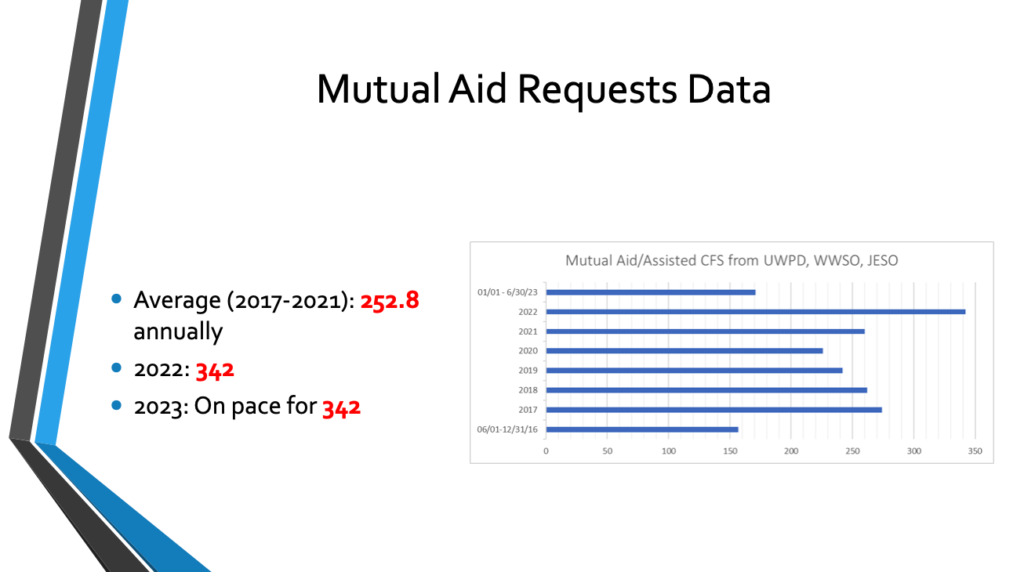
A slide, as shared by Whitewater Police Chief Dan Meyer during a Common Council meeting held last month, shows an increase in mutual aid requests placed by the department to other law enforcement agencies.

A bar graph shared last month by Whitewater Police Chief Dan Meyer shows a breakdown of calls for service placed to the department by the Whitewater Unified School District between the 2019-20 and 2022-23 school years.
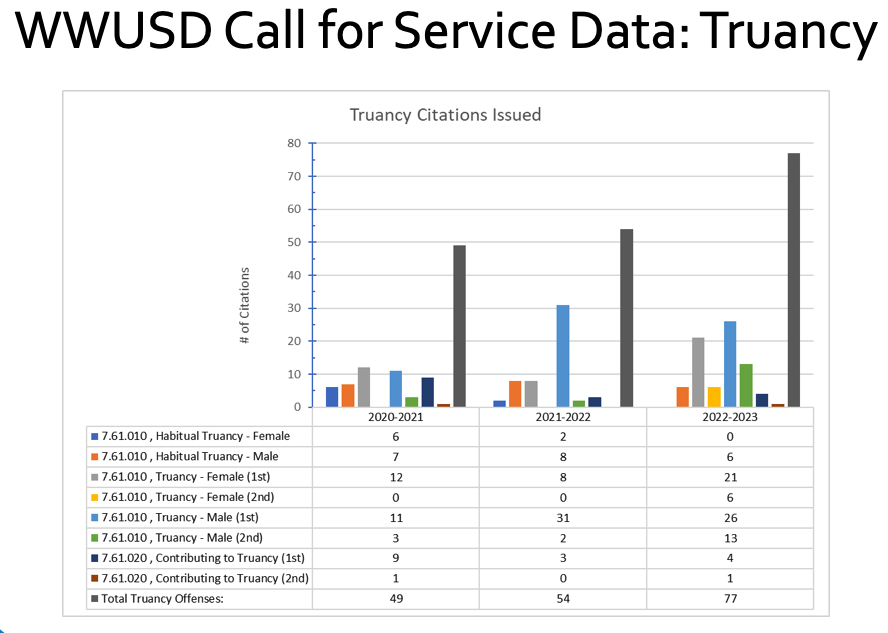
A graph shows calls for service related to truancy placed by the Whitewater Unified School District between the 2020-21 and 2022-23 school years.
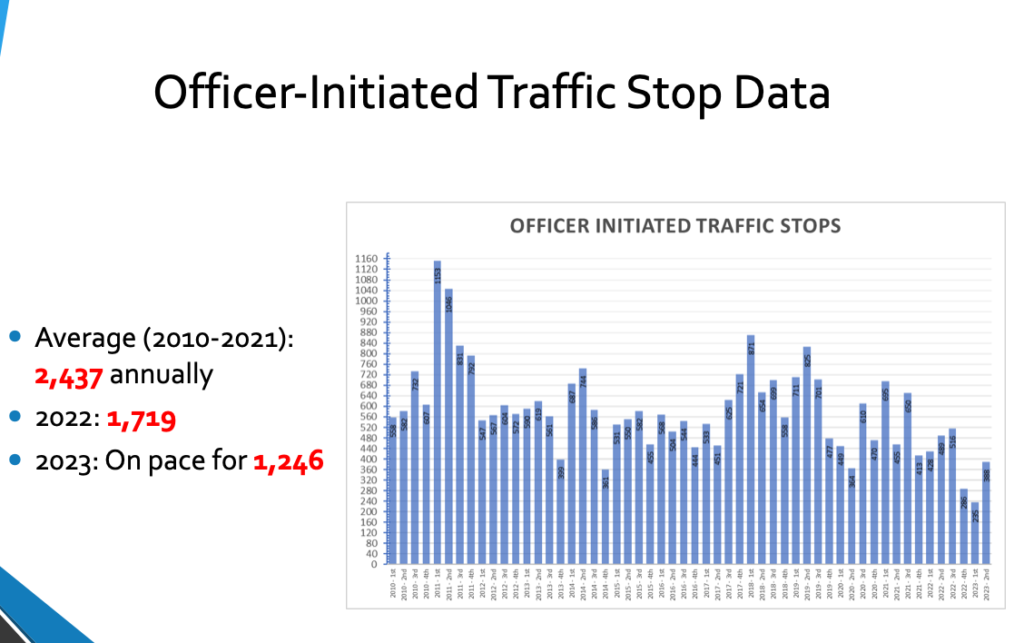
A graph shows the number of officer-initiated traffic stops between 2010 and to-date in 2023. Officer initiated traffic stops have been declining, according to Whitewater Police Chief Dan Meyer.
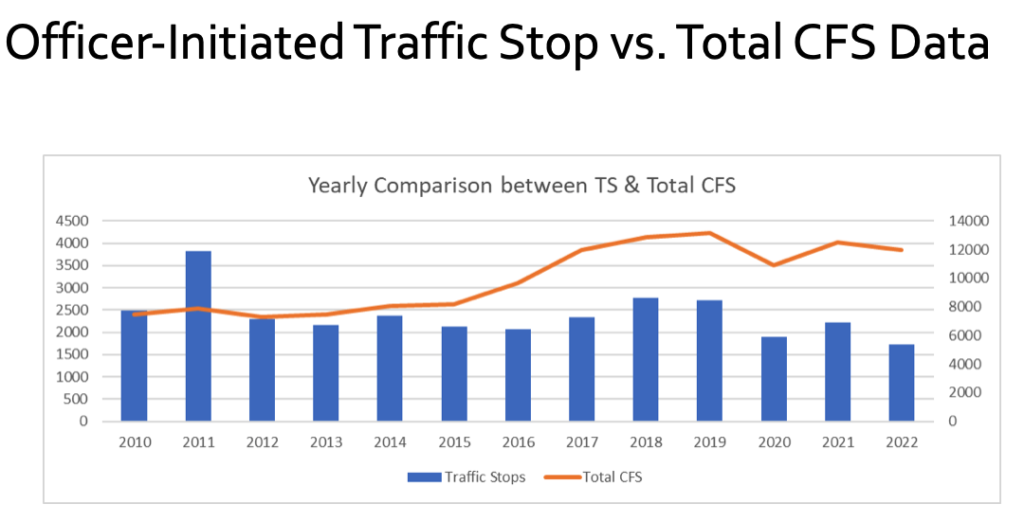
A graph shows a divergence of overall calls for service (CFS) received by the department as depicted by that orange line, which uses the scale on the right, versus the department’s ability to conduct proactive traffic stops, depicted by the bar graphs using the scale on the left. Whitewater Police Chief Dan Meyer said that while the graph does not show data collected in 2023, would the data have been included, its bar would look about half as tall as the bar shown “all the way to the right.” Meyer said the graph shows that the department is becoming “more and more reactive and less and less proactive.”
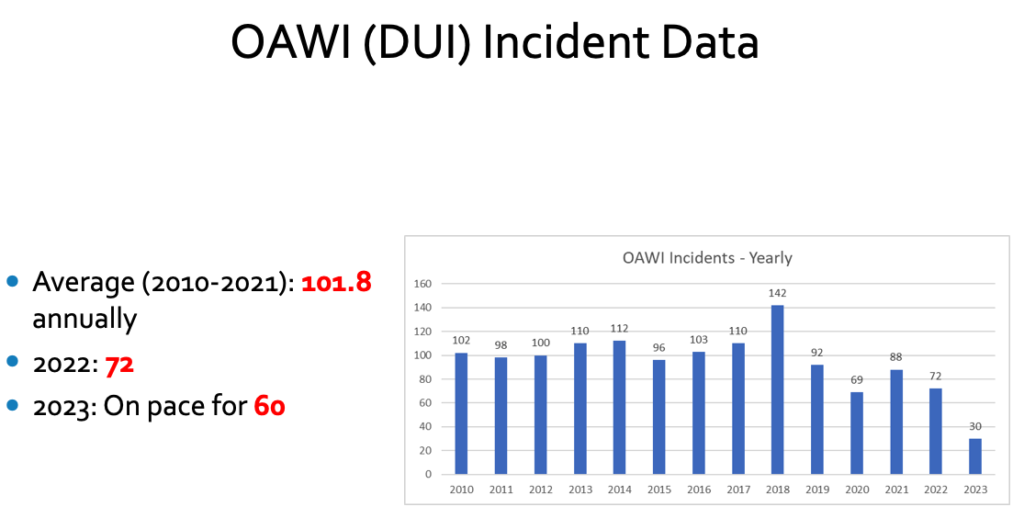
A graph shows yearly DUI incidents between 2010 and 2023 to date.
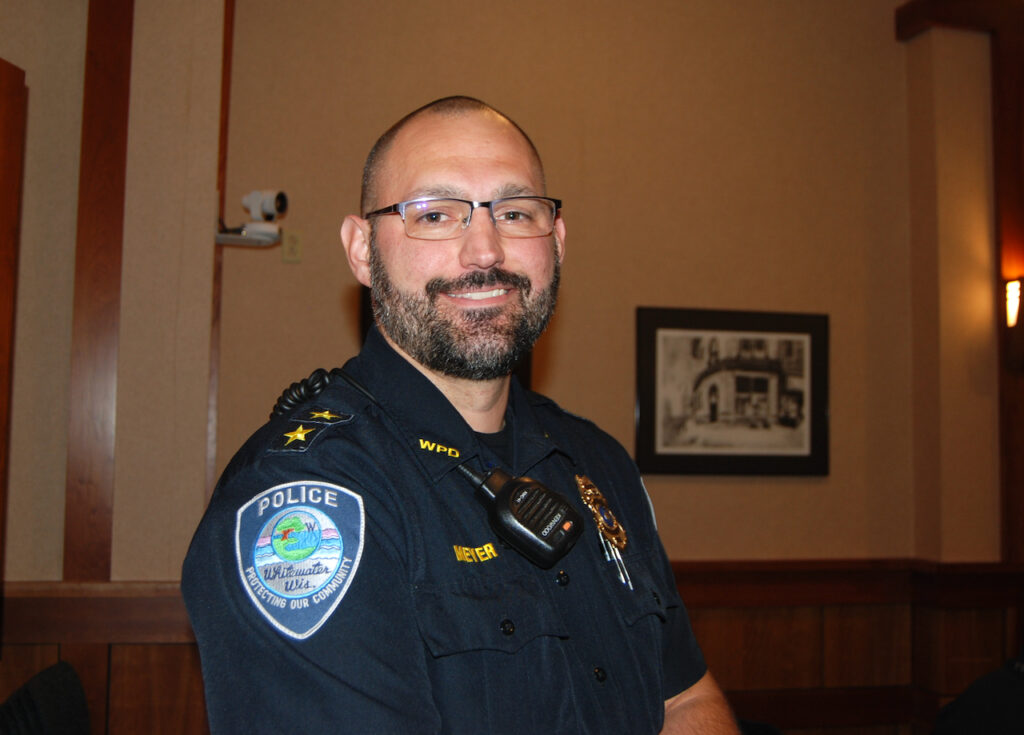
Dan Meyer, file photo/Kim McDarison.
This post has already been read 1738 times!
Kim
Our Advertisers
Most Read Posts
- Keith Leonard Thayer

- Eight finalists make the cut in Whitewater WindUp competition; winner to be chosen May 18

- UW-Whitewater students celebrate as weather warms up and school year winds down

- PSAs: Walworth Avenue to close for public works projects; recycling event scheduled

- I-43 resurfacing in Walworth County to begin May 6

- Whitewater outdoor City Market returns

- ‘Ending the Genocide: Towards a Shared Future for Palestinians and Jews’ presentation offers insight regarding Israeli-Palestinian conflict

- Road work ahead

- Whitewater Housing Roundtable SEWRPC presenter says affordable housing likely comes through smaller lot sizes, homes

- DOT: Two-phased improvement project slated for highways 11 and 12 in Walworth County










